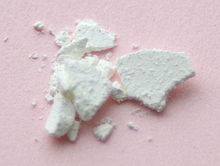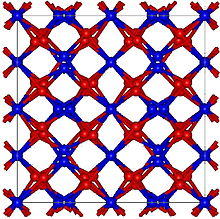 | |
 | |
| Identifiers | |
|---|---|
3D model (JSmol) | |
| ChemSpider | |
| ECHA InfoCard | 100.013.786 |
PubChem CID | |
| UNII | |
CompTox Dashboard (EPA) | |
| |
SMILES
| |
| Properties | |
Chemical formula | Dy2O3 |
| Molar mass | 372.998 g/mol |
| Appearance | pastel yellowish-greenish powder. |
| Density | 7.80 g/cm3 |
| Melting point | 2,408 °C (4,366 °F; 2,681 K)[1] |
| Negligible | |
| +89,600·10−6 cm3/mol | |
| Structure | |
Crystal structure | Cubic, cI80 |
| Ia-3, No. 206[2] | |
| Hazards | |
| Main hazards | Non-Toxic |
| Safety data sheet | External MSDS |
| Related compounds | |
Other anions | Dysprosium(III) chloride |
Other cations | Terbium(III) oxide, Holmium(III) oxide |
Except where otherwise noted, data are given for materials in their standard state (at 25 °C [77 °F], 100 kPa). | |
Dysprosium Oxide (Dy2O3) is a sesquioxide compound of the rare earth metal dysprosium. It is a pastel yellowish-greenish, slightly hygroscopic powder having specialized uses in ceramics, glass, phosphors, lasers and dysprosium metal halide lamps.
It can react with acids to produce the corresponding dysprosium(III) salts:
- Dy2O3 + 6 HCl → 2 DyCl3 + 3 H2O
References
- ^ Webelements Dysprosium trioxide
- ^ Curzon A.E., Chlebek H.G. (1973). "The observation of face centred cubic Gd, Tb, Dy, Ho, Er and Tm in the form of thin films and their oxidation". J. Phys. F. 3: 1–5. doi:10.1088/0305-4608/3/1/009.